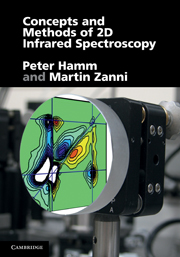Book contents
- Frontmatter
- Contents
- 1 Introduction
- 2 Designing multiple pulse experiments
- 3 Mukamelian or perturbative expansion of the density matrix
- 4 Basics of 2D IR spectroscopy
- 5 Polarization control
- 6 Molecular couplings
- 7 2D IR lineshapes
- 8 Dynamic cross-peaks
- 9 Experimental designs, data collection and processing
- 10 Simple simulation strategies
- 11 Pulse sequence design: Some examples
- Appendix A Fourier transformation
- Appendix B The ladder operator formalism
- Appendix C Units and physical constants
- Appendix D Legendre polynomials and spherical harmonics
- Appendix E Recommended reading
- References
- Index
6 - Molecular couplings
Published online by Cambridge University Press: 05 August 2012
- Frontmatter
- Contents
- 1 Introduction
- 2 Designing multiple pulse experiments
- 3 Mukamelian or perturbative expansion of the density matrix
- 4 Basics of 2D IR spectroscopy
- 5 Polarization control
- 6 Molecular couplings
- 7 2D IR lineshapes
- 8 Dynamic cross-peaks
- 9 Experimental designs, data collection and processing
- 10 Simple simulation strategies
- 11 Pulse sequence design: Some examples
- Appendix A Fourier transformation
- Appendix B The ladder operator formalism
- Appendix C Units and physical constants
- Appendix D Legendre polynomials and spherical harmonics
- Appendix E Recommended reading
- References
- Index
Summary
The most common picture of vibrational spectroscopy is that of normal modes. However, the normal mode picture is not sufficient to describe 2D IR spectroscopy without modification, because normal modes are harmonic. Anharmonicity is necessary to create 2D IR spectra. This fact can be seen from Fig. 1.5, where the negative and positive peaks of the peak pairs would overlap and cancel if the anharmonic shifts Δij were all zero. However, describing anharmonicity with normal modes is somewhat complicated.
The purpose of this chapter is to introduce a local mode description of molecular vibrations. It is a useful description for simulating 2D IR spectra and providing a conceptual framework for visualizing the vibrations of molecules, especially of molecules built from repeating units, like proteins. In the local mode description, we treat each repeat unit as a local coordinate. In a 3D structure, these local modes will be coupled, so that they vibrate in unison, forming delocalized states which are called vibrational excitons. The coupling between local modes depends on their relative distances and orientations, and thus are probes of the 3D structure.
Vibrational excitons
The term vibrational exciton is borrowed from molecular excitons, which come from studies of closely packed aggregates of optical chromophores that create delocalized electronic excitations [36]. Vibrational excitons, which are sometimes also called vibrons, deal with vibrational rather than electronic excitations. In fact, their Hamiltonians (Eq. 6.2 below) look formally the same.
- Type
- Chapter
- Information
- Concepts and Methods of 2D Infrared Spectroscopy , pp. 109 - 144Publisher: Cambridge University PressPrint publication year: 2011



